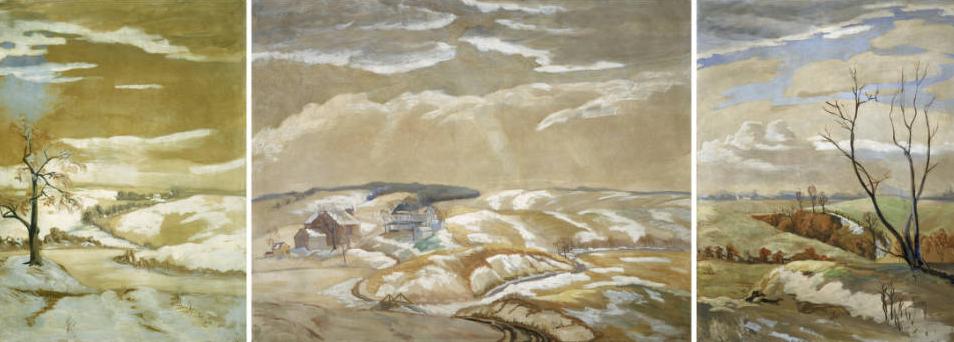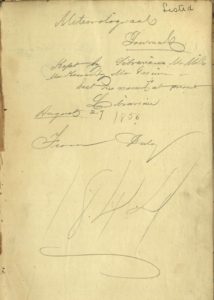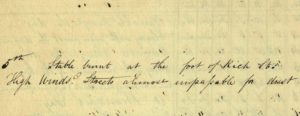How’s the Weather… Part Two

Back in August of 2013, we wrote about a weather journal that was kept by State Librarian Zechariah Mills. Mr. Mills kept track of weather conditions every day from 1838 to 1844, and also added notations on goings-on in Columbus. We believed that the journal in the State Library’s collection was the only one of its kind until a recent discovery of a second journal, held in the collection of our partners on Ohio Memory, the Ohio History Connection!

It isn’t unusual for cultural heritage institutions to transfer items to other collecting organizations. We’ve talked about this in the past; in December of 2014 we wrote about a ledger that was in the State Library’s collection but that truly belonged in the collection of the Somerset County Historical Society in New Jersey. Though the ledger, and the weather journal, were perfectly safe and secure in the collections in which they were held, their content and their original creators made them better-suited to different institutions. So when we discovered the second weather journal, a product of three State Librarians of Ohio, we requested a transfer of ownership, and the folks at the Ohio History Connection agreed.
We’re unsure as to why one journal remained at the State Library and the second traveled across town, but we initially suspected that the move took place as part of the Ohio History Connection’s collection policies. As a product of a state government agency, there are two places to which the journal would likely go: the State Library or the Ohio History Connection which, according to Ohio Revised Code 149.31, functions at the State Archives. The State Library collects print materials created by state government agencies, while the State Archives collects unpublished manuscript materials. This is over-simplified, of course, but is a safe rule: if it’s published, the State Library keeps it, and if it’s not published, it goes to the State Archives. As an unpublished product of a state government agency, the weather journal would logically go to the State Archives. However, when the weather journal was drafted, the rules for transfer were not yet in place, and the Ohio History Connection, which was known as the Ohio State Historical and Archaeological Society at its inception in 1885, had not yet been established. There is simply no way to know why the first journal stayed at the State Library while the second journal traveled across town. What we do know, however, is that it arrived at the State Library in a condition that showed considerable effort had been made by the staff at the Ohio History Connection to keep it safe and secure.
The newest weather journal begins in July of 1844, the month following the end of Zechariah Mills’ first journal, and covers the next six years, ending in December of 1850. After Mills’ departure from the State Library, his successor, Thomas Kennedy, continued the journal, as did Kennedy’s successor, John Greiner. The data gathered for each day varies from record-keeper to record-keeper; Mills tracked the temperature, weather conditions and wind direction, while Kennedy added barometric pressure and discontinued tracking weather conditions in his tables, preferring to include them in the Remarks section for each month. Greiner did not track barometric pressure and only logged temperature and wind direction. Each made note of interesting facts about Columbus, though Kennedy and Greiner typically limited those facts to weather-related anecdotes.

Mills, on the other hand, frequently noted events that took place, such as the day that the Scioto River froze over each year, or that on the 5th of April in 1845, the streets were “almost unpalatable for dust” due to high winds. On that same day he also notes that a stable burned “at the foot of Rich St.” We can imagine, from this single line, the fear people must have felt as they fought the winds while trying to put out the fire, and the incredible effort that work must have taken.
We hope you’ll take some time and explore this weather journal. And, if you haven’t done so, check out the first one, written in its entirety by Zechariah Mills. We think you’ll enjoy it!
Oh, and if you’re wondering, the temperature in Columbus exactly 170 years ago today (July 22, 1846) was tracked twice, once via an attached thermometer and once via a detached thermometer. Finding information on the difference between the two, and the resulting different readings, has been challenging, but it appears that one thermometer was attached to a barometer and the other was not. The attached thermometer measures the temperature of the mercury, while the detached thermometer measures ambient temperature. Thus, the temperature measurements may vary slightly from day to day. On July 22, 1846, however, both read the same temperature, with a high of 74° Fahrenheit.
Thank you to Shannon Kupfer, Digital Initiatives Librarian at theState Library of Ohio, for this week’s post!



Leave a Reply
You must be logged in to post a comment.